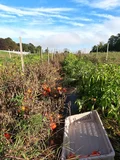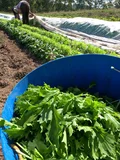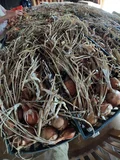TL;DR
We harvested tomatoes, gourds, mizuna, and bok choy then had lessons on tilling with an Athens 76 discing attachment.
On the tech side, I have to take tomorrow as my weekday-off to drive a standards working group meeting, but also plan to use some of that time to work on the mobile app a bit. I may also upgrade Immich…or defer that because I can chose to again.
Fall Crops Are Here
It’s really nice to turn the page on the summer heat and be out in the fields harvesting greens again in the fall temperatures. Most mornings we start with hoodies or a flannel shirt.
We are distributing onions every week. The gourds are starting to come out of the fields. Most of the flowering things that once overwhelmed the bees are now since gone, as are most of the bees, back to their colonies. Honey may come out this week, but definitely by end of next week.
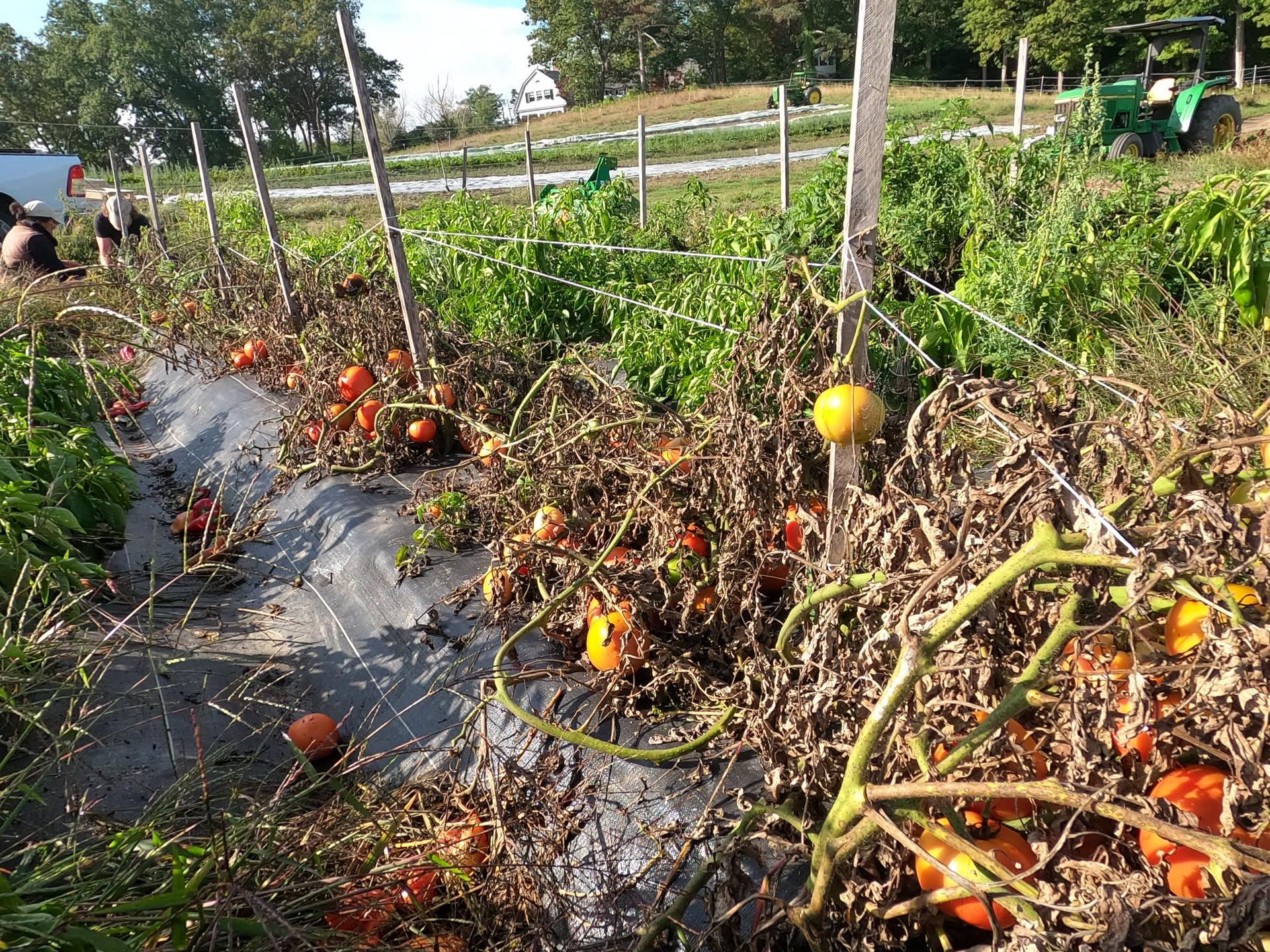
Today was “the last harvest” of the outdoor indeterminate slicer tomatoes, a bittersweet moment since that means less and less tomatoes until they’re all gone just like every season but also that there’s new work to deconstruct the trellises and start working on the soil health again.
The good news is that there are still plenty of amazing things well on their way to being harvested in the next two months: carrots, beets, potatoes, leeks, salad turnips, radishes, lettuces, broccoli rabe, pumpkins, and more.
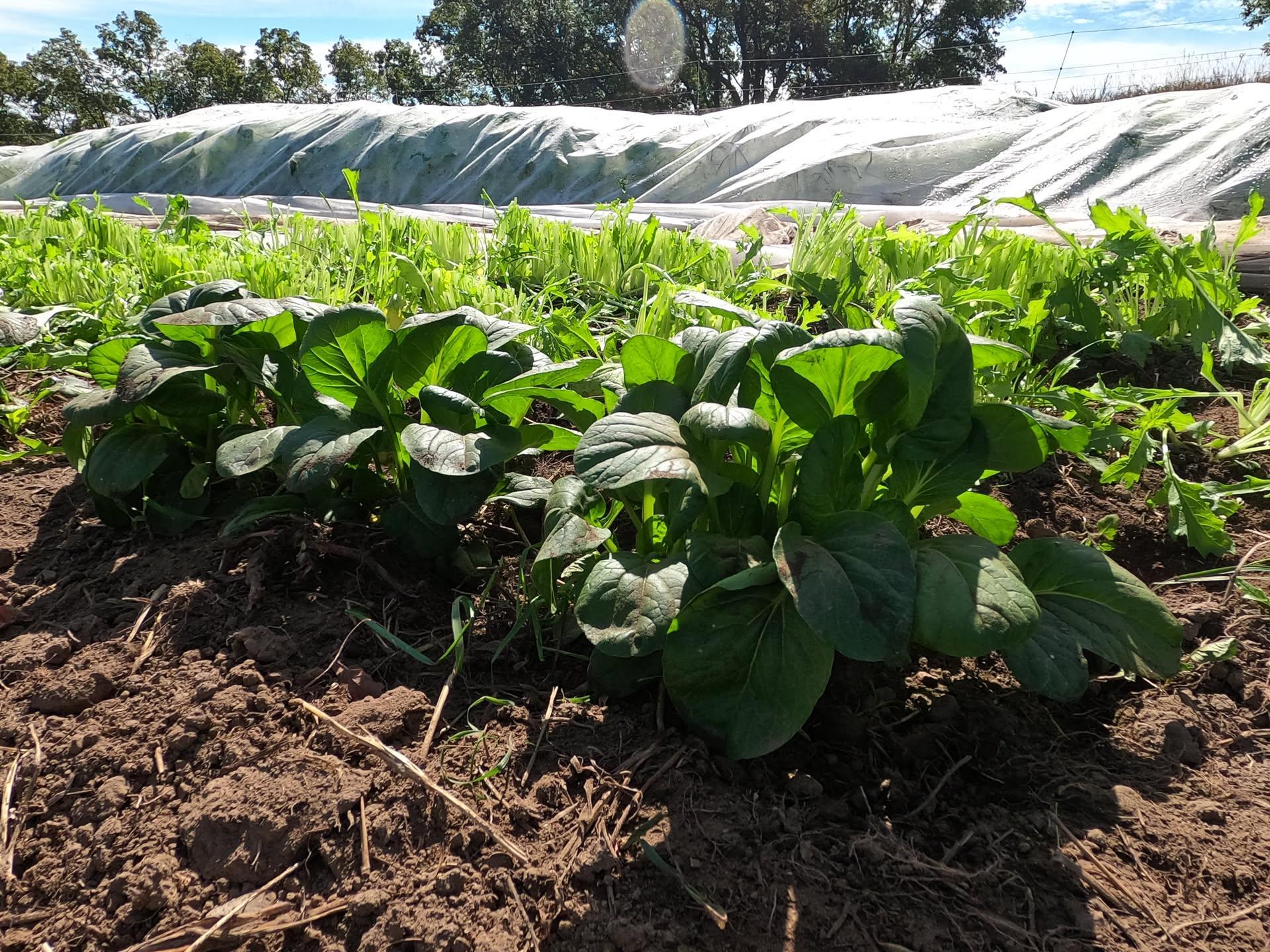
Lessons on Tractor Maintenance
Since it was a small crew in the afternoon, after we got done harvesting and since the weeds are well in check for all the upcoming crops, Jamie spend some time with the two of us in the afternoon on tractor operations and maintenance.
First, the big 2950 needed a jump because the battery had died. This happens every so often since the draw that this size tractor needs on each start sometimes is more than what the subsequent tractor session puts back in. So he navigated the smaller 6110-L close and connected some cables, let it charge a bit, then started the 2950 up and we moved it and let it sit in the main field for a bit.
Then we took turns discing some of the fields (where the fennel, cucumbers, and zucchini once were) to prepare them for a cover crop of winter rye.
Plowing, Tilling, Discing, Ripping
The best way to sound like you have no idea what you’re doing on a farm is to not use the right basic terminology. So, for my own edification and education, I clarify the following terms:
- Plowing: Deep, deep tillage to break up soil structure.
- Tilling: Shallow tillage to aerate soil and prepare for planting.
- Discing: Cutting up crop residue to break it down and mix it into the soil.
- Ripping: Breaking up hardpan soil to improve drainage and aeration.
Though this farm has a number of 3-point hitch attachments for various reasons, such as a chisel plow, a discing attachment, and a ripper, the most common attachments are the chisel plow and the discing attachment. If we plan to plant into a bed, we also use a 1953 Allis-Chalmers tractor to prepare beds and leave guiding lines in the soil.
I rarely see any unnecessary tillage beyond 6 inches and cover crops are used over the winter to maintain soil structure and biomass for the next planting season.
Digital Tillage and Cover Cropping
Since departing corporate tech life last year, I’ve been looking at many options for what kind of dual-stack career makes sense for me. Consulting is one option, but I’m also considering starting my own business or working for a non-profit.
I knew since 2023 that it was time to start cleaning up my volunteering and extra-curricular activities to make space for my new career goals. Thus, I departed the organizing pool of DevOpsDays Boston and the Boston DevOps Network early this year. I still have some responsibilities in an IEEE working group on observability, such as driving regular virtual meetings where members present and discuss various inputs to the standard’s group thought process and (eventually) writings.
The job on the farm this year, including my own commitment to write a blog post every day I’m working in order to capture thoughts and insights, has been a lot of work. At the end of November, I’m sure I’ll look back at all this content with a satisfied feeling, having created it all myself through hard work, and find additional usages over the winter until next spring when it all starts again.
Time is a resource, just like a farm’s soil. We need to use both wisely and efficiently, have a plan and a good spirit about the work in front of us. This is how I am approaching my own career goals as well as the new mobile app development work that will be a big part of my life in the coming months.
AI Summary from Field Notes
The good thing about having written the entire summarization process from scratch AND THEN using it every day is that I can quickly identify any bugs and then fix them asap. As a team of one, this is easy because I remember the nooks and crannies of the code I wrote…and I’m pretty good at leaving comments and describing work items for later use. But it takes time and context to learn how to efficiently produce code that can easily be debugged, traced, and profiled.
Many people want to tout the benefits of AI-generated code as a massive speed increase to the value developers provide, but coding is only 10-20% of that value and times pend. The real value is in breaking problems apart, finding the best options for the situation at hand, and then implementing them in a way that doesn’t cause more trouble than it should. The resulting code should be easily debuggable and maintainable with proper instrumentation and secure standards applied.
While my code for this project is not public, I always intended it to be an internal process prototype whose individual components can easily be rewritten when it comes time to open source some of them. For now, the outcomes are the most visible part of my work, such as today’s LLM-driven summary.
Summary
Consolidated Summary:
Main Themes:
- Farm Operations & Sustainability: Managing crop transitions, livestock care, and resource efficiency (e.g., irrigation, storage).
- Community Engagement & Food Systems: Addressing food waste through gleaning, surplus management, and collaboration with local organizations.
- Safety & Liability: Ensuring ethical practices, safety protocols, and legal considerations in farm operations.
Key Activities:
- Harvest and sort crops (e.g., tomatoes, mizuna).
- Prepare logistics for CSA pickups and feed distribution.
- Maintain livestock welfare (watering, feeding).
- Manage surplus produce through dehydration or gleaning.
- Coordinate with local organizations for community support.
New Insights/Discoveries:
- Gleaning Practices: Reducing food waste while supporting community needs.
- Disc System & Irrigation: Efficient tools for crop management and water conservation.
- Dehydration of Surplus: Preserving imperfect produce for later use.
- Structured Protocols: Guidelines for ethical and safe surplus handling.
Key Questions/Research Areas:
- How effective is gleaning for reducing waste and supporting communities?
- What safety and liability measures are needed for gleaning partnerships?
- How can irrigation systems (e.g., pond pumps) be optimized for scalability?
- What are the impacts of gleaning on spoilage, sustainability, and community engagement?
- Are there existing models for structured gleaning (e.g., partnerships with food pantries)?
Suggested Actions:
- Develop Gleaning Protocols: Establish guidelines for safety, liability, and ethical surplus use.
- Improve Irrigation Systems: Invest in efficient tools (e.g., hydrants, pond pumps) to reduce water waste.
- Collaborate with Local Groups: Partner with food pantries or community organizations for surplus distribution.
- Educate Volunteers: Train gleaners on farm safety, crop handling, and responsible surplus use.
- Document and Reflect: Track insights from gleaning and agricultural practices to refine future strategies.
Part 1
Main Themes:
- End of the Tomato Harvest Season: The intern is documenting the final tomato harvest, highlighting the care and effort invested in these plants.
- Transition to Fall and Winter Crops: The focus shifts to preparing for the next season, emphasizing the transition from summer to fall/winter crops.
- Harvesting and Preparing for Multiple Crops: The intern is involved in harvesting various vegetables (tomatoes, eggplant, gourds, squash) and preparing them for distribution or storage.
Activities Performed by the Intern:
- Cleaned buckets (likely for harvesting or storage).
- Harvested indeterminate outdoor tomatoes (final harvest of this variety).
- Harvested eggplant (still producing).
- Collected gourds and butternut squash (clipped in the morning, including delicata squash).
- Worked in the field with three people (including the intern, Jamie, and another worker).
- Documented the process in field notes, noting the progression of crops.
New Things Not Yet Encountered:
- Fall/Winter Crops: The intern mentions moving on to “fall CSA share and winter crops,” but the transcript does not describe specific activities or challenges related to these crops.
- Techniques for Fall/Winter Crops: The intern may be encountering new methods or challenges for crops like winter squash, gourds, or CSA share logistics.
Questions and Future Areas of Research:
- Impact of Weather on Fall/Winter Crops: How will temperature or precipitation affect the growth of fall/winter crops?
- Harvest Timing for Fall Crops: What is the optimal time to begin harvesting gourds, butternut squash, or other fall crops?
- Yield and Quality of Current Harvests: How do the current tomato, eggplant, and squash yields compare to previous seasons?
- Efficiency of Harvesting Techniques: Are the current methods for harvesting gourds or squash sustainable for larger-scale operations?
- Transition Planning: How to best prepare the field or workforce for the next season’s crops?
Suggested Actions:
- Plan for Fall/Winter Crops: Develop a schedule or strategy for transitioning to fall/winter crops, including crop rotation or new planting methods.
- Document Harvest Data: Record details about the current harvest (e.g., weight, yield, quality) for comparison with future seasons.
- Train Workers on New Crops: Ensure all team members understand the care and harvesting techniques for fall/winter crops.
- Monitor Weather Patterns: Track weather forecasts to anticipate potential challenges for fall/winter crops.
- Prepare Storage/Processing Tools: Ensure equipment (e.g., buckets, tools) is ready for harvesting and storing fall/winter crops.
Part 2
Main Themes
- Agricultural Work and Crop Management: Harvesting various crops (gourds, mizuna, bok choy, onions), handling damaged crops, and storing produce.
- Irrigation Systems: Managing a pond pump, priming the pump, and addressing irrigation challenges (e.g., water pooling, pump efficiency).
- Tractor Use and Soil Preparation: Using a disc system for tilling, understanding tractor operations, and preparing soil for cover crops.
- Sustainability and Infrastructure: Discussing potential improvements (e.g., hydrants, irrigation layout) and storage solutions.
Activities Performed by the Intern
- Harvested butternut squash, mizuna, and bok choy (with some damage from flea beetles).
- Collected onions from the horse barn for drying.
- Used a tractor with a disc system to till soil for cover crops.
- Primed the pond pump for irrigation.
- Moved irrigation pipes and managed water flow.
- Stored heavy gourds in a dry kitchen (for non-refrigerated produce).
New Things Encountered
- Disc System on Tractor: A tool for tilling soil, which the intern is learning to use.
- Pond Pump Irrigation: A system where water is drawn from a pond, requiring manual priming.
- Flea Beetle Damage: A pest issue affecting bok choy, requiring attention to crop health.
- Root Cellar-Like Storage: A dry, low-light area for non-refrigerated produce (e.g., tomatoes, apples).
Questions and Future Research Areas
- Effectiveness of Disc System: How does the disc system impact soil preparation for cover crops?
- Flea Beetle Management: What strategies can be implemented to mitigate flea beetle damage to bok choy?
- Irrigation Efficiency: How can the pond pump system be optimized to reduce priming frequency and water waste?
- Sustainability of Current Setup: Are the current irrigation and storage practices scalable for larger operations?
- Tractor Training: How can the intern improve their understanding of tractor maintenance and soil preparation techniques?
Suggested Actions
- Invest in Local Hydrants: To improve water access for irrigation, reducing reliance on the current pond system.
- Improve Irrigation Layout: Address water pooling and pump priming issues by redesigning pipe paths or adding water reservoirs.
- Monitor Crop Health: Implement pest control measures (e.g., traps, organic sprays) to protect bok choy from flea beetles.
- Expand Storage Solutions: Enhance the dry kitchen area to store more non-refrigerated produce.
- Training on Tractor Use: Seek additional training or resources to master tractor operations and soil preparation techniques.
Part 3
Main Themes:
- Farm Operations and CSA Preparation: Packing mizuna, preparing for a CSA pickup, and managing logistics for a farm distribution.
- Animal Care and Feed Management: Watering pigs and chickens, filling feed bags, and ensuring proper hydration for animals.
- Crop Harvesting and Sorting: Selecting and sorting tomatoes for quality, dealing with imperfect produce, and addressing spoilage concerns.
- Gleaning and Food Waste: Reflections on the practice of gleaning (picking leftover crops before they spoil), its ethical and logistical challenges, and the need for structured protocols.
- Safety and Liability in Farm Work: Concerns about untrained individuals accessing farms, the need for safety measures, and liability waivers.
Activities Performed by the Intern:
- Pack 45 small bags of mizuna for the Essex pickup location.
- Assisted in preparing the electric van for CSA distribution.
- Watered pigs and chickens.
- Filled feed bags for tomorrow morning and restocked water for the animals.
- Sorted tomatoes: selected “best of the best” for sale, left imperfect tomatoes in piles, and collected them into a tray for dehydration.
New Things Not Yet Encountered:
- Gleaning Practices: The intern first reflects on the concept of gleaning, including its role in food waste reduction and community support.
- Structured Gleaning Protocols: The intern considers the need for guidelines (e.g., safety training, liability waivers, payment for staff).
- Dehydration of Imperfect Produce: The intern plans to dehydrate the sorted tray of tomatoes for use at home.
Questions and Future Research Areas:
- Feasibility of Gleaning: How can farms balance food waste reduction with liability risks?
- Safety and Training: What safety protocols are needed for gleaning? How to ensure gleaners understand farm operations?
- Liability and Legal Framework: Should farms require liability waivers for gleaning? How to structure payment for staff involved?
- Impact of Gleaning: How does gleaning affect crop spoilage, farm economics, and community engagement?
- Existing Models: Are there existing frameworks for structured gleaning (e.g., partnerships with food pantries, professional gleaners)?
Suggested Actions:
- Develop a Gleaning Protocol: Create guidelines for gleaning, including safety training, liability waivers, and staff involvement.
- Collaborate with Local Organizations: Partner with food pantries or community groups to distribute gleaned produce.
- Research Existing Practices: Investigate how other farms or organizations handle gleaning to identify best practices.
- Educate Gleaners: Provide training for gleaning volunteers on farm safety, crop handling, and ethical use of surplus produce.
- Document and Share Insights: Record the intern’s reflections on gleaning to inform future farm practices or community programs.
[end of post]
Enjoy Reading This Article?
Here are some more articles you might like to read next:

